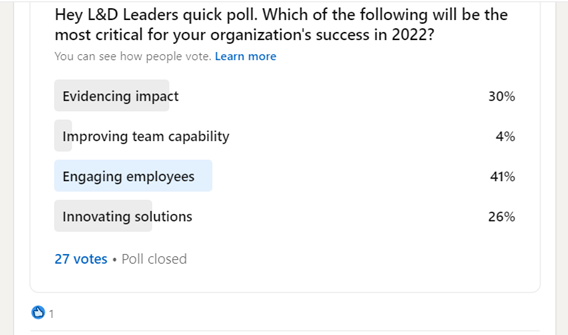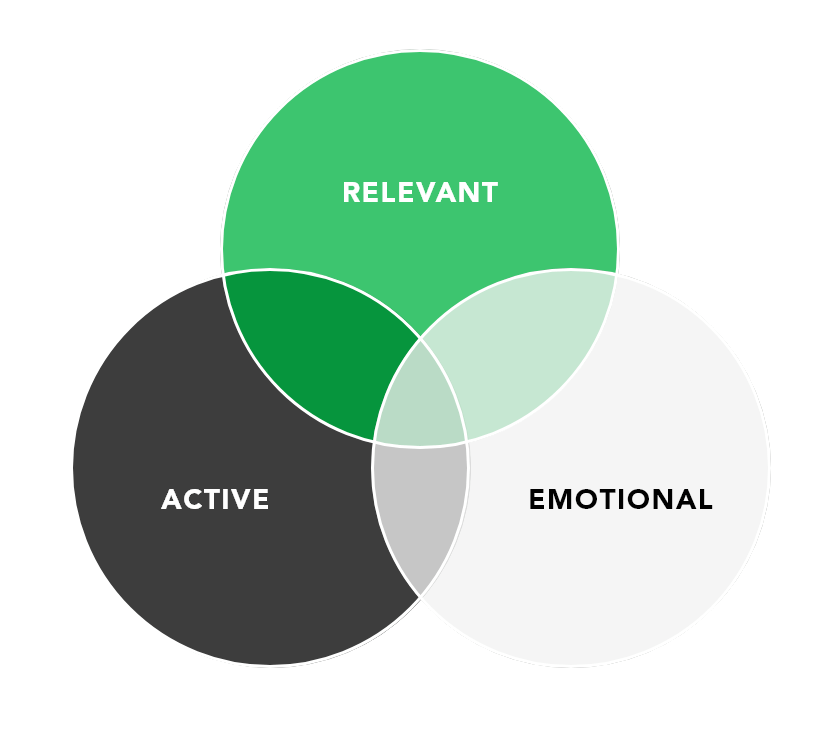Make It Active, Relevant, And Emotional
At the start of the year I conducted a poll on LinkedIn asking the L&D community (or at least those of you I'm connected with!) which of the following will be most critical to the learning success of their organization in 2022:
- Evidencing impact
- Improving team capability
- Engaging employees
- Innovating solutions
At 41% of responses, "engaging employees" was the clear priority.

With the "great resignation" impacting most organizations and the ongoing challenges resulting from our (seemingly) never-ending pandemic, it's no surprise engaging employees is top of this list, but this begs the questions of what is learner engagement and how do we create the conditions for it to happen?
My 30+ years of experience tell me that engagement is the intersection of three Instructional Design strategies:
Make it active. Make it relevant. Make it emotional.

- Active learning stimulates attention, creates the opportunity for feedback, and engages the perception-action cycle (a.k.a. learn-by-doing).
- Relevance is important because it helps connect new content or concepts to prior experiences and existing knowledge. Our brain then knows which scripts need to be changed, updated, or expanded (see script theory).
- Emotion drives attention and enhances memory and recall.
Instructional strategies that engage learners typically tick the box on one or more of these. Below, I've provided a list of 10 instructional strategies we use at Kineo to make learning more engaging.
1. Diagnostic Assessments
A fancy way of saying "test-out option," whereby you can tailor the learning experience to reflect the existing knowledge of the learner, making it more relevant. By giving learners the opportunity to test out or adjust the learning pathway, you help them focus only on what is relevant.
2. Case Studies
Case studies provide context and have the potential to increase relevance. If you can, use real-life examples that are relevant to your business or create examples that feel realistic.
3. Stories
Stories also provide context and, when written well, introduce emotion. Provoke curiosity and get people thinking by leading with stories in which they apply their situational judgement in a safe environment. Let them analyze a realistic work-related situation and solve the problem. Draw people to and through the content with high-engagement and creative approaches that engage the learner.
4. Branching Courses
Branching courses allow for different users to have different experiences and content that is more relevant to their role, experience, or background. You can offer different content to different audiences or multiple pathways through the learning. We recommend using content filters, like a role selector or assessment option, to give learners personalized learning pathways based on their role or the results of an initial assessment at the beginning of the course.
5. Scenarios
Scenarios provide active learning and, when done well, evoke an emotional response. You can create scenarios that challenge the learner to make decisions and then present the consequences. Each consequence can produce a new challenge and decision to be taken by the learner.
6. Performance Scorecards
Performance scorecards that track a learner's decisions as they progress through a scenario provide the basis of meaningful, personalized feedback, making the experience more relevant. It shows how a learner makes decisions when needing to balance several potentially conflicting priorities. By attaching a score to each competing priority, learners can see how they prioritize needs and expose any biases.
7. Gamification
Gamification elements like points and leaderboards can evoke emotion and generate interest. Using game mechanics also helps to get into the grey areas that exist between correct and incorrect, while also adding an element of risk and consequence when learners are tackling multiple-choice questions.
8. Rich Media
Rich media elements like video and animation can be used to evoke emotion and can help make complex content easier to comprehend. Including a mix of different media types also helps make the learning feel more active, as learners work through the learning.
9. Strong Imagery
Strong imagery can evoke emotion and create relevance. You don't always need video and animation; a great image paired with the right content can be impactful in the learning experience.
10. Characters
Using characters as a vehicle to present content versus third-person voice can create relevance and even emotion. Bring stories to life with characters that feel real and relevant to your business.
Learning and Development is at the core of employee experience! So, go ahead; use some of these approaches in your next learning project.

Originally published at kineo.com.

